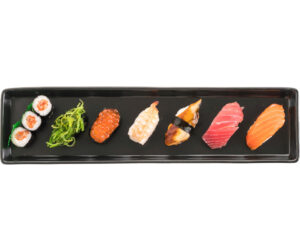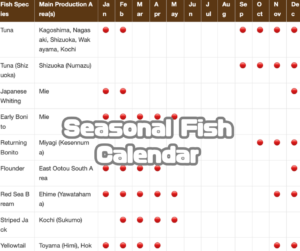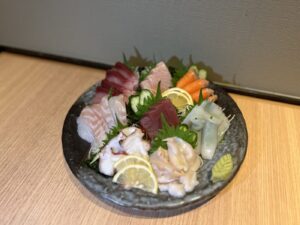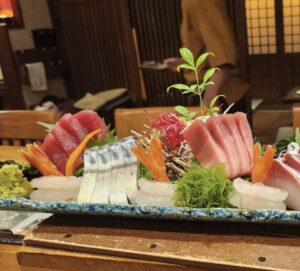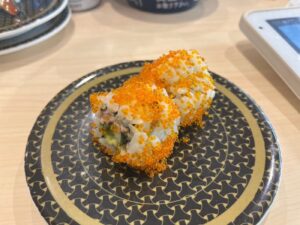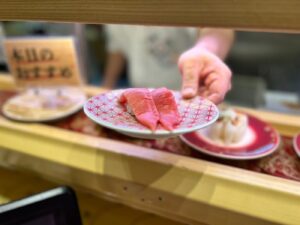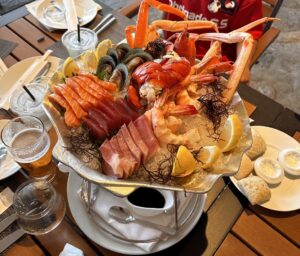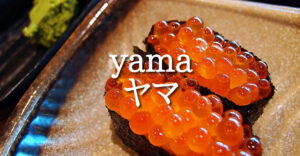“I want to know more about the history of sushi!”
Hello. I am Tsuya, the young proprietress of Sushi Kappo Kuroshio.
“Sushi” can now be eaten at restaurants such as conveyor belt sushi restaurants.
Sushi is a uniquely Japanese culture, but how did it come into existence?
Also, how did Japanese culture evolve?
In this article, in order to answer the questions above, the young proprietress of a sushi restaurant will introduce the culture and history of sushi, which is extremely popular all over the world.
By knowing more about the culture and history, you will be able to enjoy sushi even more!
Please read to the end.

table of contents
1 1. What is the culture and origin of sushi?|It was a preserved food of Southeast Asia
2 2.What kind of food is sushi?
3 3. What is the culture and history of sushi? The original form is Narezushi, a fermented food
3.1 The appearance of “namanare” in the Muromachi period
3.2 The culture of nigiri sushi was born in the Edo period
3.3 Sashimi became a topping in the Meiji era
3.4 Conveyor belt sushi appeared in the Showa era!
4 4. There are three types of notations for sushi.
4.1 Sushi
4.2 Sushi
4.3 Sushi
5 5. [800 years old] Where is the oldest sushi restaurant in Japan?
6 6. What is the culture of sushi and etiquette when eating it?
6.1 Eat sushi with your hands
6.2 Eat sushi in one bite
6.3 Add soy sauce to the toppings
7 7. Frequently asked questions about sushi culture and history
7.1 Is there an order in which to eat sushi?
7.2 What are some terms related to sushi?
7.2.1 Agari
7.2.2 Shari
7.2.3 Namida
7.3 Is it true that sushi is good for your health?
7.4 Is sushi popular overseas?
8 8. Sushi has an ancient culture and was first eaten as a preserved food!
Where does the culture and origin of sushi come from?
Tracing the culture and history of sushi, it was originally a preserved food from Southeast Asia.
It is said that it was introduced to China from Southeast Asia, and then to Japan along with the technique of growing rice.
The oldest Japanese document that mentions sushi is the Yoro Rei, a law enacted in 718 AD.
In the Yoro Rei, the words “abalone sushi” and “small fish sushi” are written.
Abalone sushi is abalone that has been pickled in salt, and small fish sushi is simmered jaco.
Since ancient times, humans have loved eating abalone!
I learned that the culture and origins of sushi are very old, and that it has been eaten since the Nara period.
2.What kind of food is sushi?
What kind of food is sushi?
Sushi is a Japanese dish consisting of vinegared rice combined with seafood and other toppings.
Seafood is the most common topping, but there are other toppings other than seafood, such as:
- meat
- vegetables
- egg
Also, when you hear the word sushi, the first thing that comes to mind is nigiri sushi, which is vinegared rice with toppings on top.
However, there are other types of sushi besides nigiri sushi, such as the ones listed below.
- Hand-rolled sushi
- Sushi rolls
- warship
- hand-rolled sushi
- pressed sushi
- Inarizushi
- chirashi sushi
- bar sushi
- Temari sushi
There are so many types of sushi!
Sushi is sushi, but each type of sushi has a different culture and history.
In the next chapter, we will introduce in detail what the “original sushi” that is the origin of sushi was.
3. What is the culture and history of sushi? The original form is Narezushi, a fermented food
I learned that the culture and history of sushi is very old, but the earliest sushi was completely different from the sushi we eat today.
At that time, sushi was a fermented food called narezushi, which was made by fermenting fish with salt and rice.
Narezushi was created because fish spoils quickly, so by fermenting it, it can be preserved for a long time.
Funazushi, which is famous as a specialty of Shiga Prefecture, continues to be made in a traditional way.
Funazushi does not use vinegar, which is important in sushi.
As someone who works at a sushi restaurant, I’m often surprised when I hear that sushi doesn’t use vinegar.
Funazushi uses rice only for fermentation, and when it is actually eaten, the fermented rice is removed.
Funazushi is characterized by its unique aroma because the rice is fermented.
It’s so moving to think that the delicious sushi that we eat today is possible because of carp sushi and narezushi!
The emergence of “namanare” in the Muromachi period
Narezushi has been eaten for a long time since its creation.
In the Muromachi period, the fermentation time was shortened, and rice, which had previously been removed when eaten, began to be eaten together.
This was the birth of sushi called “Namanare”.
With the birth of Namanare, sushi, which was previously eaten as a fermented and preserved food, can now be eaten as rice.
Then, in the Edo period, sushi, which had previously only been eaten by noble people, became available to the common people.
During the Edo period, the number of sushi restaurants increased rapidly not only in Edo but also in Osaka and Kyoto.
As someone who loves sushi, I’m happy to be able to share the deliciousness of sushi with so many people!
The culture of nigiri sushi was born in the Edo period.
Then, in the late Edo period, the much-awaited “Nigiri Sushi” appeared.
However, even though it is called nigiri sushi, it is not the nigiri sushi that you might imagine.
At this time, nigiri sushi was about the size of a rice ball, so it was not large enough to be eaten in one bite.
Furthermore, the term “Edomae sushi” that we often hear today refers to the nigiri sushi that was popular in Edo around this time.
Edomae sushi was popular in Edo, and pressed sushi and stick sushi were popular in Kyoto and Osaka.
Therefore, the sushi below is called Osaka sushi, as opposed to Edomae sushi.
- pressed sushi
- bar sushi
- Battera
Even though it is the same type of sushi, the types of sushi that are popular change depending on the place and time, probably because sushi has a long history.
It was during the Meiji era that the topping became sashimi.

In the Meiji period, the toppings began to be eaten as sashimi.
With the development of the ice-making industry, it became possible to transport live fish to distant places, and it became possible to enjoy raw fish deliciously.
At that time, there were no refrigerators, so ice-making technology was extremely innovative and was used in a variety of situations!
The current style of Edomae sushi, which involves coating the toppings with soy sauce, was established during the Meiji period.
Then, in the Taisho era, with the advent of refrigerators, sushi restaurants were able to store a variety of toppings.
Items that were originally large are now being served in bite-sized pieces.
I feel happy and sad…!
By the way, the idea of sushi being served in sets of two pieces is said to have started when sushi, which used to be large, was divided into two pieces to make it easier to eat.
In Taisho 12, the Great Kanto Earthquake occurred, and as a result, sushi chefs from the Kanto region moved across the country.
Edomae sushi, which was popular in the Kanto region, spread throughout the country and can now be eaten in various regions.
It’s ironic that sushi became available all over Japan because of the earthquake, but…!
I would like to make sushi with gratitude and respect for the history that has come before.
Conveyor belt sushi appeared in the Showa era!
In the Showa era, the now familiar conveyor belt sushi appeared.
As the Showa era entered a period of high economic growth, the traditional sushi stalls that had been commonplace were discontinued due to hygiene reasons.
However, the first conveyor belt sushi in world history appeared in Osaka in 1955.
The world’s first conveyor belt sushi restaurant was called “Mawaru Genroku Sushi No. 1” run by Genroku Sangyo Co., Ltd.
For us, conveyor belt sushi is a common occurrence, but for people overseas, seeing sushi being passed around is a strange sight!
After that, conveyor belt sushi spread throughout the country, and sushi became popular with the common people again as a food that was hygienic.
Nowadays, sushi can be eaten anywhere, but it has such a deep culture and history.
4.There are three types of notations for sushi.
Did you know that there are three types of sushi?
Here, we will introduce three types of sushi and their meanings in detail.
- sushi
- sushi
- sushi
sushi
First of all, “sushi” is the most commonly used food in modern times.
The notation “sushi” is said to be an auspicious character used to represent good luck.
Shou” means good things and long life, andShiru” means to symbolize and comes from “Sushi no Shiru.”
There is also a strong theory that the word comes from “juji,” which is a word used to celebrate longevity.
“Sushi” and “Sushi”, which will be explained later, are not suitable for sushi that does not use fish as an ingredient, but “sushi” can be used for all kinds of sushi.
sushi
Next is “sushi,” which is still sometimes seen in modern times.
The kanji for sushi” meansdelicious fish,” so as the name suggests, it is often used to mean “sushi made with delicious fish.”
In particular, sushi restaurants that serve Edomae sushi often use the term “sushi.”
The reason for this is that there were no refrigerators during the Edo period, and the skill of the craftsmen was important in order to serve delicious sushi.
For this reason, Edomae Sushi’s commitment to providing delicious fish” is written assushi.”
sushi
The oldest word for sushi is “Sushi”.
The meaning of sushi is the kanji fish bias” and vinegar” (tsukuri), so it refers to fermented and preserved foods such as the aforementioned narezushi.
The word sushi is not often used these days, but it is sometimes used for Kansai-style sushi such as mackerel sushi and carp sushi.
5.[800 years old] Where is the oldest sushi restaurant in Japan?
Do you know where the oldest sushi restaurant in Japan is located?
The oldest sushi restaurant in Japan is “Tsurube Sushi Yasuke” located in Yoshino District, Nara Prefecture.
We have been serving delicious sushi for 800 years since our establishment.
800 years ago, it goes back to the Heian period, so you can understand how much history it has.
Tsurube Sushi Yasuke does not serve Narezushi, but you can enjoy a variety of sushi including sweetfish sushi.
6.What is the culture of sushi and etiquette when eating it?
Here we will introduce etiquette when eating sushi.
The etiquette that I will introduce from now on is basically important, but the most important thing is to eat in a way that you think is the most delicious.
Please respect your manners, but don’t get too tied down and enjoy your sushi!
- eat sushi with your hands
- Eat sushi in one bite
- Add soy sauce to the toppings
eat sushi with your hands

Etiquette when eating sushi is to eat with your hands, not with chopsticks.
Nowadays, we live in a world where people are very conscious about hygiene, so most people eat sushi with chopsticks.
Of course, if you are concerned about hygiene, please try eating delicious sushi with chopsticks!
However, sushi is made by sushi chefs who use a variety of techniques and commitment.
The air is finely adjusted when holding the sushi so that the rice will loosen up just the right amount when you put it in your mouth.
Therefore, if you pick up sushi with chopsticks, it may lose its shape or the sushi may become hard due to too much pressure.
To enjoy the true taste of sushi, try eating it with your hands!
Eat sushi in one bite
Eating in one bite is the etiquette when eating sushi.
Sushi chefs fine-tune the seasoning with the premise that the sushi will be eaten in one bite.
Generally, we offer slightly smaller pieces of rice to women and children, but if by any chance the rice is too big, feel free to tell them that you would like it to be smaller.
Our sushi chefs provide the best sushi that suits each customer so that each customer can enjoy the most delicious meal.
Add soy sauce to the toppings
It is good etiquette when eating sushi to add soy sauce to the toppings rather than the sushi rice.
At counter-only sushi restaurants that serve Edomae sushi, the sushi may be served with soy sauce applied to the toppings.
The reasons for this are as follows.
- To prevent customers from applying more soy sauce than necessary
- To prevent it from losing its shape when adding soy sauce
- To provide sushi in its best condition
- To reduce the need for customers to add soy sauce and allow them to eat immediately.
For the reasons mentioned above, some restaurants serve sushi with soy sauce applied to the toppings.
However, there are some sushi restaurants that are more accommodating to their customers and say, “We want customers to add the amount of soy sauce they like.”
If you’re at a sushi restaurant where you add your own soy sauce, please dip the toppings in the soy sauce instead of the sushi rice and enjoy the sushi!
7.Frequently asked questions about sushi culture and history
Finally, we will introduce frequently asked questions about the culture and history of sushi.
By knowing the frequently asked questions about sushi, you will be able to enjoy sushi even more.
- Is there an order in which to eat sushi?
- What are some terms used in sushi?
- Is it true that sushi is good for your health?
- Is sushi popular overseas?
Is there an order in which to eat sushi?
The ideal order to eat sushi is “light toppings → flavorful toppings → rolls”.
Using the ingredients commonly found in actual sushi restaurants as an example, I separated the lighter toppings from the more flavorful toppings.
Refreshing topic
- White meat
- squid
- octopus
- Kohada
- egg
Items with strong flavor
- Toro
- salmon roe
- sea urchin
- conger eel
As mentioned above, you can enjoy the flavor of each topping by eating a lighter topping followed by a more flavorful topping.
If you start eating with a richly flavored topping, you will find it difficult to appreciate the flavor of the lighter toppings.
It is said that the most delicious way to eat sushi is to finish it off with a roll.
What are some terms used in sushi?
Sushi restaurants use a variety of technical terms.
Here we will introduce three technical terms often used at sushi restaurants.
Agari
Agari refers to hot tea.
In the past, the name “Arigarihana” was used to refer to the tea drunk at the end of a meal and the departure of the guests.
The term Agari” was born from this word Agari”.
By the way, it’s free no matter how many drinks you have at a sushi restaurant, so feel free to refill!
Shari
Shari refers to vinegared rice.
The origin of the word shari is that the bones of Buddha are called sariras, so the name shari came to be derived from the sariras.
By the way, at some sushi restaurants, sushi is sometimes called “senmatsu.”
Namida
Namida refers to wasabi.
Eating wasabi makes your nose sting and make you water, which is why it was called “Namida.”
That’s a fancy terminology!
There are many stylish terms used in sushi restaurants, such as namida.
Is it true that sushi is good for your health?
Sushi has long been loved as a healthy food.
By eating sushi, you can expect the following effects.
- balance hormones
- Make your skin shiny
- Activate brain function
- Sushi has the ability to balance hormones in the body.
The seaweed used in sushi contains a lot of iodine, which helps balance hormones.
Sushi is also rich in antioxidants, which may help slow down cell damage and aging.
It slows cell aging and keeps your skin glowing.
In addition, fish contains a lot of omega-3 fatty acids, which activate brain function, and have the following effects.
- Improved concentration
- Improved cognitive ability
- Suppression of cholesterol levels
- Control of high blood pressure
- In addition to this, sushi can be expected to have various other health benefits.
I will introduce it in detail in another article.
Is sushi popular overseas?

In conclusion, sushi has become a popular food all over the world.
In countries like Japan, where there is no culture of eating raw fish, sushi that is uniquely adapted to that country has appeared.
One of the famous sushi is “California Roll”.
As the name suggests, California roll is a type of sushi roll that originated in California.
In America, there is little culture of eating raw fish, so some people may not like sushi.
For those who don’t like raw fish, California rolls are made with crab sticks and avocado.
We also use a method of making sushi called “uramaki,” where the seaweed is placed on the inside.
The reason why uramaki is used is because there are few black foods overseas, so many people don’t like the color of seaweed.
Isn’t it romantic that the sushi culture that started in Japan is now eaten by people all over the world?
8.Sushi has an ancient culture and was first eaten as a preserved food!
In this article, we introduced the culture and history of sushi, which is extremely popular all over the world.
The culture and history of sushi can be summarized as follows.
Summary of sushi history and culture
・Sushi was born in Southeast Asia
・Narezushi has been eaten in Japan since the Nara period.
・“Namanare” appeared in the Muromachi period
・Nigiri sushi was born in the Edo period.
・In the Meiji era, the material became sashimi.
・Conveyor belt sushi was born in the Showa era.
Sushi has such a long and deep history and culture!
I hope that by learning more about the culture and history of sushi, you can enjoy it even more.

